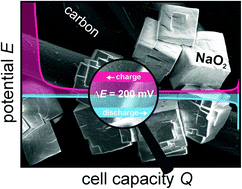A comprehensive study on the cell chemistry of the sodium superoxide (NaO2) battery†
Abstract
This work reports on the cell chemistry of a room temperature sodium–oxygen battery using an electrolyte of

* Corresponding authors
a
Physikalisch-Chemisches Institut, Justus-Liebig-Universität Gießen, Heinrich-Buff-Ring 58, 35392 Gießen, Germany
E-mail:
juergen.janek@phys.chemie.uni-giessen.de, philipp.adelhelm@phys.chemie.uni-giessen.de
b BASF SE, 67056 Ludwigshafen, Germany
c Max-Planck-Institut für Festkörperforschung, Heisenbergstrasse 1, D-70569 Stuttgart, Germany
This work reports on the cell chemistry of a room temperature sodium–oxygen battery using an electrolyte of

 Please wait while we load your content...
Something went wrong. Try again?
Please wait while we load your content...
Something went wrong. Try again?
P. Hartmann, C. L. Bender, J. Sann, A. K. Dürr, M. Jansen, J. Janek and P. Adelhelm, Phys. Chem. Chem. Phys., 2013, 15, 11661 DOI: 10.1039/C3CP50930C
To request permission to reproduce material from this article, please go to the Copyright Clearance Center request page.
If you are an author contributing to an RSC publication, you do not need to request permission provided correct acknowledgement is given.
If you are the author of this article, you do not need to request permission to reproduce figures and diagrams provided correct acknowledgement is given. If you want to reproduce the whole article in a third-party publication (excluding your thesis/dissertation for which permission is not required) please go to the Copyright Clearance Center request page.
Read more about how to correctly acknowledge RSC content.
 Fetching data from CrossRef.
Fetching data from CrossRef.
This may take some time to load.
Loading related content
